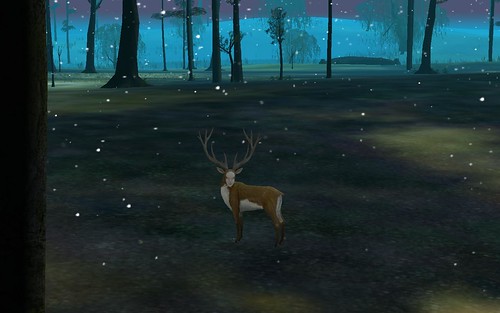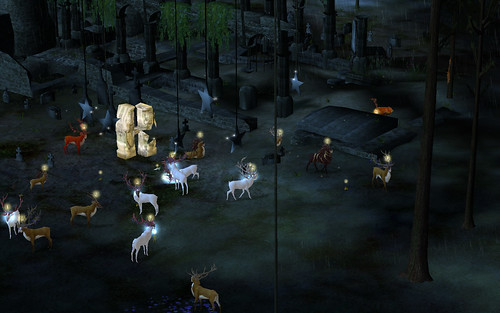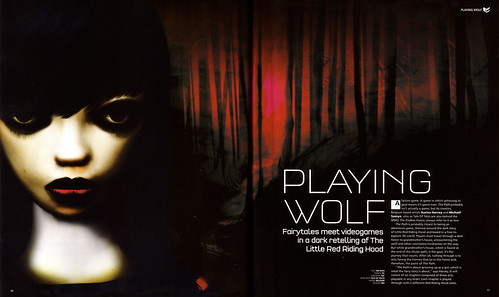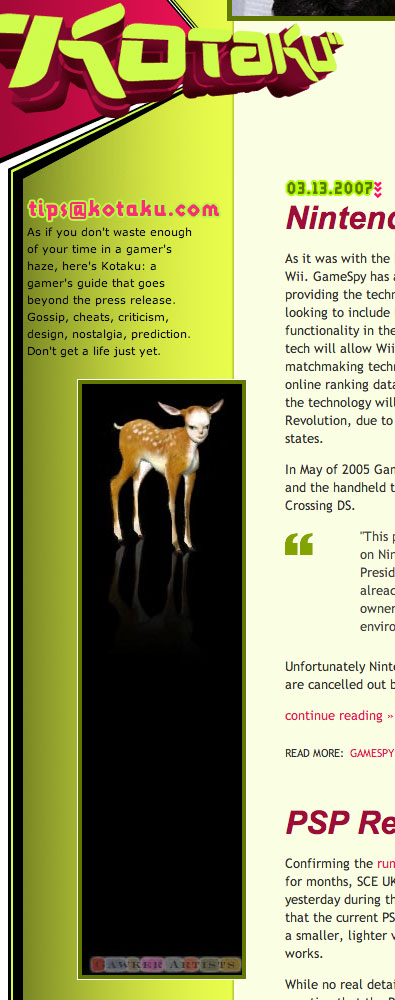Here’s an interview with us, mostly about The Path, conducted a while ago, now (re)posted on the NeoGAF forums.
Category: Press
The Path on Gamespot UK
Emma Boyes has posted her impressions of a first look at our current internal demo for The Path on Gamespot UK. There’s also a little interview with me (although Auriea and I always do everything together).
Good games, bad games, ugly games
Reading through the avalanches of comments on the inappropriate appropriation of Jeff Minter’s recent Livejournal posts by video games news sites, makes me realize the extent of the immaturity of games as a medium and a culture.
Mr Minter made a personal statement in his journal about how he is saddened by the fact that remakes of old games sell better than new original games, based on sales figures he got from XBox Live Arcade; where his own Space Giraffe game is competing for some measly Dollars with age-old classics like Frogger. In any other subculture, the audience would sympathise with the underdog. Not so in the games industry. Most of the comments advise Mr Minter to “stop whining” and “make a good game instead”. The latter really bugs me.
I may not personally like Space Giraffe as a game any better than Frogger (I don’t know that because I don’t own an XBox). But does that mean it’s a bad game?
Gamers, in general, and often hand-in-hand with the games press, seem to think that there is an objective standard for games to be judged by. That there’s good games and bad games. And more importantly, that everybody better agree on what constitutes a good game. Because if you don’t, then you’re an idiot, a moron, somebody who knows nothing about games, etcetera.
Hey, I may have been guilty of this myself on occasion.
But it’s horrible, isn’t it?
Whatever happened to personal taste? Why can we not simply like or dislike a game? Instead calling it good or bad? And how about different people liking and disliking different types of games? That they don’t like to play a certain game, does not mean that they are illiterate idiots, does it? And even if they are not very knowledgable about games, don’t they still have the right to like or dislike a particular game?
I may like or dislike Space Giraffe as a game. But I have no end of admiration for what Jeff Minter is doing: to make a game from his own personal vision, to experiment with game structures and aesthetics, to make something that did not exist before! I wish that the games industry would be more supportive of that. If only because it is thanks to the work of people like Mr Minter that the medium grows and the industry expands.
Or is that exactly what those commenters are afraid of?
I don’t think we can do much about the trolls who comment to blogs. But we can support this work on a higher level. Microsoft, for a start, should realize that games like Space Giraffe require special attention. They need to create a custom-made marketing campaign that prepares the consumer for what the game is really like. And they probably need to create a special channel on their service for games like this. So that it doesn’t seem like they’re competing with games that fall in a completely different category. Next, the press should try to educate the audience about this. Instead of circling around people’s personal online journals like vultures waiting for a juicy bit to rise to the surface. Surely journalists have the experience and know-how to realize the importance of exploration and experimentation in the games industry. They should support this practice as much as they can!
I hope, in the future, releasing a game does not feel so much like taking an exam. As developers, we are interested in hearing people’s opinions. But they are only useful when we know where they are coming from. And nobody has the right to “grade” our work. Games are not right or wrong. Games are liked or disliked. By people. Different kinds of people like different kinds of things. There’s nothing wrong with that.
And game developers are only human. They don’t owe gamers a “good game”… Developers owe it to themselves to follow their vision and make games with love and care.
The Path in EDGE Magazine
What more to say than simply that. An interview and a few kind words appear as a 4 page feature about our game in development, The Path, in the December 2007 issue of UK games publication extraordinaire Edge Magazine. It’s a great article and it looks beautiful so you should pick it up!
Ahem, to say we’re happy about this would be an understatement(!) For now, I think I’m still in shock.
We’re brilliant!
If you don’t believe us, read the well thought through article by chris on The Artful Gamer. I quote:
They are brilliant.
Seriously, the article contains a very interesting analysis of different forms of play. And how many computer games seem to miss out on a lot of opportunities for play. It reminded me a bit of our own post about Player-created gameplay but it takes the concept even further.
The Endless Forest featured in GEE magazine, Germany
Tale of Tales on Austrian radio tonight
Tonight, Austrian national radio ORF 1 will be broadcasting a report on Belgian new media art, at 22.30, during the Matrix show. The half hour documentary was made by Armin Medosch after his visit to Belgium last Spring.
You can listen to it only during the time of the broadcast by going to the channels website http://oe1.orf.at/ and clicking on ‘webradio‘ on the top.
Simultaneously, a story about Tale of Tales has been published (in German).
Games journalists and The New Games
The review of Flow by Richard Leadbetter on Eurogamer made me think. I’ll start by quoting the last line of the article:
If you’re looking for something more like a conventional game, I’d lop off a mark or two from the final score.
That score being 7 out of 10.
The largest part of the article describes the mechanics of Flow. In terms of objective, avatars, attacks, moves and levels. When it finally arrives at talking about the aesthetics of the experience, it calls the game a tech demo and goes on about HDR, HD and THX as norms to judge beauty by.
I have not played Flow on the PS3. But I have played the Flash version, seen some video footage and read about several players’ experiences with the game. It is quite clear that Flow is not a game like most. That its focus is not on gameplay as such but on a different kind of interactive experience, an experience that inspired its title. I’m happy that games websites report on products like this because I think they are extremely important for the future of the industry. But after reading the review, I’m starting to doubt whether games journalists should be the ones doing this job.
It’s a bit like having sports commentators criticizing a fine art exhibition. Not that I want to make a big issue about Flow being art or something. But it does seem to be designed with different purposes and require a different attitude than that of a games journalist (or a gamer for that matter). Not necessarily so these kinds of games could get better scores. But because their scores might be better motivated. Now it seems too much like judging an opera performance based on the cut of the dress of the soprano. It might be an ugly dress, but that’s hardly the point.
On the other hand, there is a lesson here for us, designers interested in new forms of games. Electroplankton is a similar game with one big difference: it has no traditional gameplay to speak of. Perhaps as a result of this, it doesn’t get criticized quite so negatively as Flow might. Perhaps, games journalists realize that a “pointless” experience like Electroplankton completely escapes their grasp.
This seems like a smart strategy. Stay away from gameplay. Don’t give them anything that would allow your game to be compared to Mario or World of Warcraft. Concentrate on what your game is really about. And leave out the redundant stuff. Even Richard Leadbetter can’t help but admit how good such a thing can be.
It’s disappointingly bereft of content, but I can’t help but like it for what it is, and its mere presence on the XMB often makes me load it up as a distraction during my working day.
They are not made out of stone. They are people. They can be moved.
I hope the future brings us journalists who can actually write a review about that side of their experience. Aren’t there supposed to be “New Games Journalists”? Or has that fad faded? Maybe the New Games Journalists should talk about the New Games. Makes sense to me.
The Endless Forest part of the Gawker Artists network
Not too long ago we got the bright idea to look into the Gawker Artists network. Basically, it is a link list of artists curated by Gumshoe. They oversee the distribution of artist ad banners through blogs like Gizmodo, Treehugger, Kotaku, Lifehacker etc., not to mention private bloggers who’ve signed up to get the ads on their pages. If you’ve ever been surfing through some of these bigger tech or game blogs you may have seen these ads. Its like a sudden non-sequitor in the middle of an article… at least they always caused me to do a double-take. I think it’s a pretty nifty idea to give free ad space to artists, it decorates the page and give people something to think about instead of asking them to become another link in the consumerist chain. So, it was pretty straightforward to sign up for and we’ve been getting a decent number of hits from it. Plus it is pretty cool to see banner ads for The Endless Forest “in the wild.”
Click here to see all the banners…
Ten Thousand Deer In The Virtual Woods
We sent this out yesterday…
FOR IMMEDIATE RELEASE
Ten thousand Deer in the virtual Woods
The Endless Forest crosses the 10,000 registered users mark
Today, the number of confirmed registered players of The Endless Forest has exceeded ten thousand, while the artistic game project has been downloaded over 64,000 times since its first release in September 2005.The Endless Forest is a social screensaver. A multiplayer game without goals or chat. A peaceful environment where every player is represented as a deer, running around, rubbing trees and sleeping in the sun. And casting Forest Magic on each other or partying under a night sky filled with floral fireworks during ABIOGENESIS, a spectacle created in realtime by authors Auriea Harvey and Michael Samyn whenever the mood hits them.Tale of Tales is a Belgian games development company founded by former internet artists Auriea Harvey and Michael Samyn, better known as “Entropy8Zuper!”. Their goal is to explore the potential of the games medium as an artistically expressive form of entertainment.
The Endless Forest is supported by Musée d’Art Moderne Grand-Duc Jean in Luxemburg, Vlaams Audiovisueel Fonds and Design Vlaanderen.
The Endless Forest can be downloaded for free from
http://Tale-of-Tales.com/TheEndlessForest/








